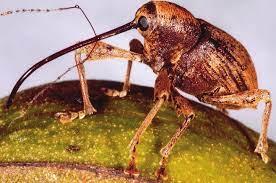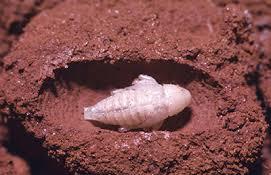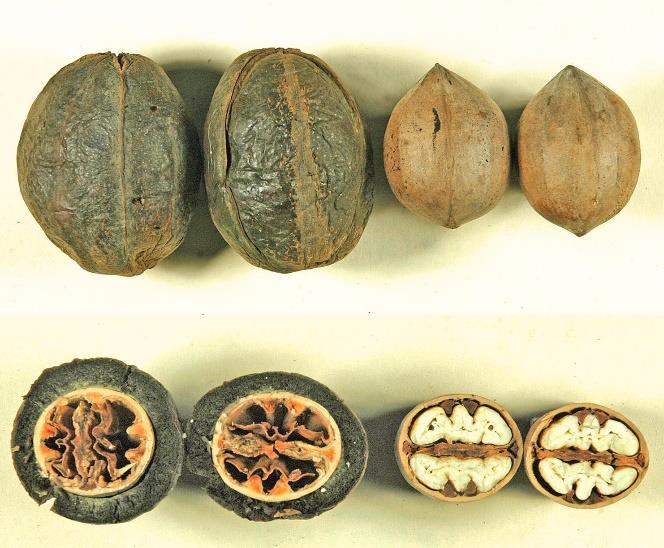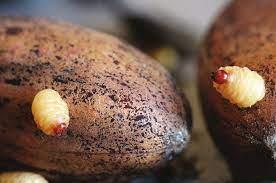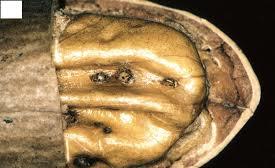Pecan Weevil Season is Here
Pecan weevil season is in full swing across the state. Our “normal” peak in weevil occurs in mid to late September; however, due to heavy rains that occurred in several areas of the state early to mid-August, weevil emergence (especially in sandier soils) began early and could continue into October. Damage from pecan weevil can vary from year to year and orchard to orchard. This insect represents one of the major pecan pests that can severely limit production and quality of the pecan crop (Fig. 1). In addition to the injury on the crop itself, buyers and processors who purchase infested pecans must either clean them out or dispose of the product.
Figure 1. Adult Pecan Weevil.
The typical life cycle of the pecan weevil requires 2 to 3 years, with the majority of weevils emerging two years after burrowing into the soil. Once a weevil larva enters the soil it has matured through four instars. The final instar (fourth) may feed for a short while in the nut (about 1-2 weeks) and then burrows out of the nut and drops to the ground generally spending one to two years in the soil without feeding. Larvae will burrow into the soil at various depths depending on soil type, moisture, and condition of the orchard floor. Most larvae are likely 6-9 inches deep in the soil profile and protected by an earthen cell (Fig.2).
Figure 2. Earthen Cell.
Ninety percent of the larvae that entered the soil on “year 1” will pupate in “year 2.” The remainder of the population will not pupate until “year 3.” The pupal stage lasts for about 3 weeks and the adults then remain inactive within the earthen cell constructed earlier by the larva and do not attempt emergence from the soil until “year 3” (about 2 years after they entered the soil as larvae). After emergence from the soil adult weevils live for about 2 to 3 weeks. If nuts are not ready for oviposition by female weevils, then adults will cause feeding damage on the nuts. This damage may consist of feeding punctures, prior to shell hardening, which will cause premature drop of the pecan. Feeding by pecan weevil after shell hardening may cause the deterioration of the gel resulting in “sticktights.” If the weevil penetrates only the shuck, then damage may be limited to slight scars, black spots, pits, or molds on the kernel near the puncture site (pictures below).
Pecan Weevil Damage. Sticktights.
Pecan Weevil Damage. Larval feeding.
Pecan Weevil Damage. Larval Emergence.
Pecan Weevil Damage. Black Spot.
Oviposition by female pecan weevils can occur as early as 2 days after emergence; however, the majority of egg production occurs 10-12 days after emergence. Regardless of how soon oviposition begins, it is initiated on early maturing varieties sooner than on trees that have late maturing nuts. Currently, early maturing cultivars at the OSU Cimmaron Valley Research Station have been in the dough stage for several weeks and have been treated twice for pecan weevil. As of this publication, Circle trap monitoring has indicated continued emergence. Each female can average around 35-75 eggs deposited during her life. She will average about 2-4 eggs per nut. With a healthy weevil population, this can account for a great amount of damage.
Much of the damage experienced by pecan weevil can be avoided with timely use of insecticides. Making the decision on when to treat; however, can be a dilemma for many growers. Although increased weevil emergence can occur after heavy rainfall events in late July and August, in Oklahoma the majority emerge in September, but this can be highly variable depending on many factors. This year early rainfall events have pushed early emergence in some areas. Late August is generally when early maturing cultivars are susceptible (dough stage) for oviposition, so orchard monitoring is crucial during this time. Subsequent treatments should be based on some sort of trapping program. For trapping we suggest the pecan weevil Circle trap. Although growers have become familiar with these traps over the last few years, many questions remain on how to best utilize the traps. Several studies conducted in Oklahoma over the years have helped provide some answers to many of these questions. Following are several suggestions on the utility of the Circle trap and methods for arriving at a treatment threshold based on captures.
- Commercial situations (several trees) – Use as many as you can afford, to represent the land area, soil types, pecan varieties, and topography in your area.
- Where possible, target indicator trees – Those with a history of weevil problems, those that are earlier than most, or those located in sandy soils.
- Place two traps on each targeted tree. One on the north, west or northwest side of the tree and the other just opposite. Set them at a height suitable for your operation. If cattle are going to be grazing the orchard floor, then put the traps sufficiently high on the trunk to avoid their natural curiosity. Just remember that someone needs to check traps regularly, therefore, they should be reachable for the person doing the checking. Where cattle are present, a small step ladder or truck pickup bed will help. Soon after placement on the trees, cattle lose their curiosity with these traps, probably for two reasons. First, they’re made of screening material, which they don’t prefer to chew on and second because after a few days they tend to recognize the trap as part of the tree.
- When attempting to encircle the tree trunk, place additional wire screening wherever the traps don’t match up and curl the top lip of the screening over to funnel the weevils up into the trap tops.
- Mow grass under the trees to avoid providing weevils a spot to take off (fly) into the canopy.
- Begin trapping by July 15 if possible, but don’t be overly concerned if the nuts are still in the water stage.
- Do not cease trapping too early (before mid-October).
- Inspect traps at least every 2 to 3 days. Set up a M-W-F checking schedule and stick to it.
- Keep a running set of written records, to include date of trap inspection, number of weevils caught, sex of weevils caught, and tree number or location. This information should be retained for long term records and can help you identify indicator spots and/or trees.
- Convert the total number of weevils collected from all traps on each inspection date into the number of weevils/trap/day. In other words, the total number of weevils from “X” traps after “X” number of days. EXAMPLE: You examined 16 traps on 8 trees on Monday and found nothing but on Wednesday you gathered up 12 weevils from the same 16 traps. Therefore, divide 12 by (16 times 2). The two represents the days since your last check of the traps. 12/32= 0.375 weevils/trap/day.
- Begin control measures if the number of weevils equals or exceeds 0.3 weevils/trap/day.
- Be sure to regularly clean the trap screen tops to remove spiders, lacewings, webbing, and dead insects which may interfere with functioning of the trap. A stiff toothbrush can help in this task.
- Be diligent in this task from July to October, but really focus immediately following any 1”-2” rainfall. If conditions are hot and dry, as they often are in July and August, weevil emergence may be delayed but can still be significant up until shuck-split. In Oklahoma, populations generally peak about the third week of September.
- When an application is about to be made, remove the top cylinder of each trap to allow everything to crawl through. Air-blast sprayers and the insecticide will cause many weevils to fall from the canopy shortly after treatment. These “sick weevils” will begin crawling up tree trunks and entering traps. This can give the impression of an ineffective treatment or that you had a fresh emergence. Leave tops off for a period of 7 days, then begin the monitoring program again.
- Finally, if the first application of an insecticide causes flare up in the aphid population, or if aphids are problematic before that application, incorporate an aphicide (e.g. – Closer®, Carbine®, Movento®, etc.). This can save you from a sticky mess that can result in moldy pecans and early defoliation, the latter of which can affect fruit set for the following year.
For homeowners that may have one or a few trees, it may be possible to “trap-out” much of their weevil population by encircling the trees with traps and following the same suggestions. This may reduce the number of insecticide applications needed in this sensitive environment and yet preserve pecans for harvesting. In localized “hot pockets,” where weevils have relied on a few trees in the area, thorough monitoring, and treatment over a two-to-three-year period can dramatically reduce or even eliminate the pecan weevil for several years.
More information on pecan weevil and its control can be found in EPP-7079, Biology and Control of Pecan Weevil and CR-6209, Commercial Pecan Insect and Disease Control.

